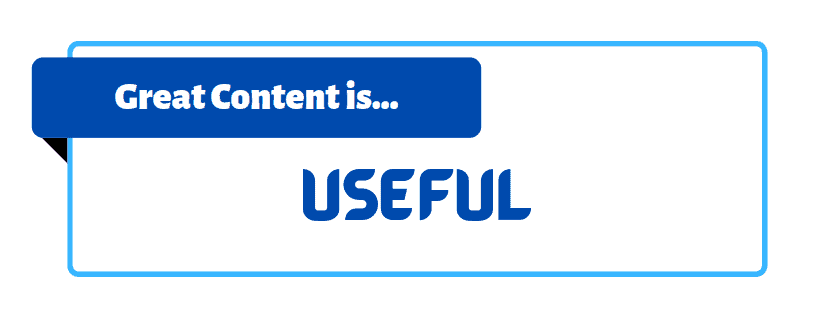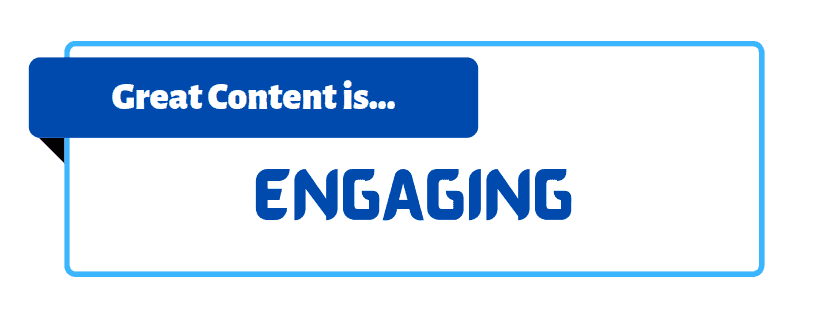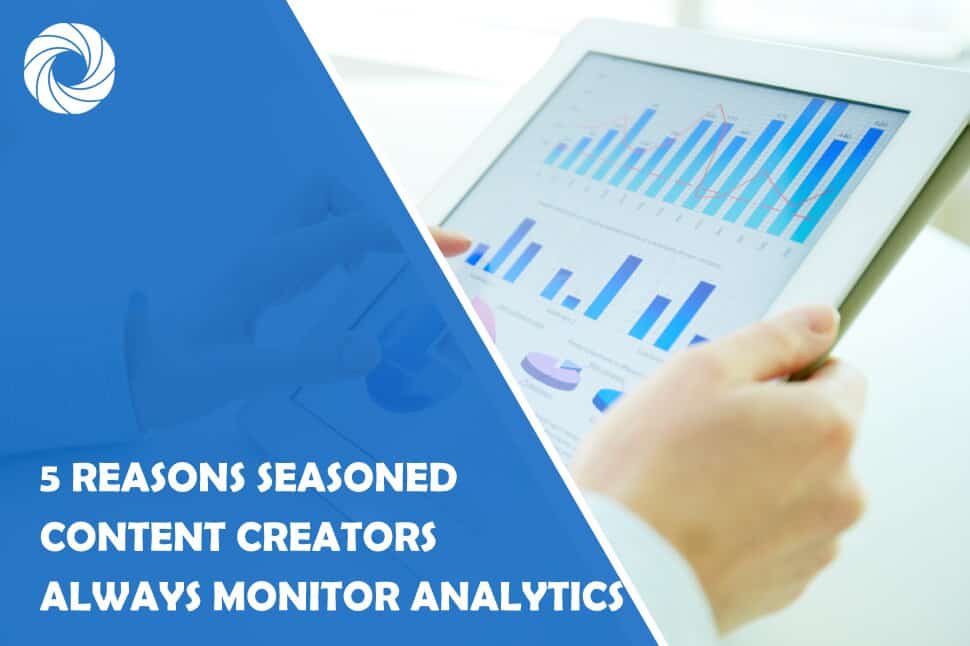You wouldn’t send out an email marketing campaign without checking your open rate. Nor would you put out a sponsored social media post without keeping an eye on engagement. Yet many businesses dive into content creation without monitoring analytics.
But, before we take a look at the main reasons seasoned content creators monitor analytics, let’s consider what makes great content – and what analytics you need to watch.
Seasoned content creators don’t just monitor analytics, they rely on them. By the end of this article, you’re going to rely on them as well.
What Makes Great Content?
There’s a range of content marketing methods out there, but they all have the same thing at the core: great content. Content marketing is about offering value. Not about selling a product. Monitoring analytics helps you identify what your audience wants.
Great Content is Useful

Answer the question your audience is asking. If they’re worried about cybersecurity using VoIP, tell them how to avoid the risks. If they want to know about the best monitors to use a second screen, provide a list. It’s not about what you want to tell them – it’s about what they want to know.
Great Content is Engaging

You have options when it comes to creating content. If you’re a telecommunications brand, like RingCentral, have you thought about creating a video about the benefits of VoIP for businesses? Or an email course? Both already sound more engaging than a “how-to guide”.
Great Content is High-Quality
High-quality content is free from grammatical and spelling errors, full of relevant up-to-date information, and backed up by reliable sources.
Data-Driven Content Creation
Data-driven marketing took off back in the 2000s and has become crucial in all digital strategies. Everything from online customer service to social media management now depends on data. Over half of businesses (51%) are basing more decisions on data analytics, so no wonder that tools like ScraperBox became a popular choice for web scrappers.
The right data can tell you everything you need to know about an audience, including how to engage them.
What Analytics Should You Monitor?
Every business is different. Your content creation objectives won’t be the same as everyone else’s. Because of that, everyone needs to monitor different analytics.
Some people create content to drive organic traffic to their website. Others want to build a customer database for email marketing, or are trying to build an army of loyal, returning customers.
Your content marketing objectives will tell you what analytics you should monitor. Common analytics that you might be interested in are:
- New vs. returning customers
- Bounce rate
- Downloads
- Form submissions
- Dwell time
- Social media shares
What you choose to monitor is up to you. Take your content marketing objectives into account and make sure you are asking the right questions when it comes to data collection.
Asking the Right Questions
Seasoned content creators ask the right questions. They monitor analytics to track the return on investment (ROI) their content produces. But they also want to make sure the next piece of content they create is better than the last.
What are the right questions? That depends on you and your goals. Are you trying to increase sales of your latest call center solutions? Do you want more organic traffic or social media engagement? Would you like to increase brand awareness?
These are all achievable goals with a strong content creation strategy. But only if you are asking the right questions. Make the most of cloud collaboration technologies and get your team involved in collecting and analyzing data.
How to Monitor Analytics
One such tool is Google Analytics. This monitors everything that happens on your website. It can track visitors by location, device, and acquisition. The software can also give you insights into dwell time, bounce rate, and behavior. It’s free and easy to install on your website.
Your second priority should be social media analytics. Chances are if you’re creating great content you are distributing it on social media. Most platforms offer free analytics with a business account. This allows you to see what time and day of the week your audience is active, what type of content they engage with most, and even gives you insights into your audience demographics.
How Does Monitoring Analytics Help You Create Great Content?
Here are five reasons seasoned content creators always monitor analytics:
1. Pinpoint Your Buyer’s Journey
Search engines are getting better at monitoring intent. If you aim to drive people to your website then you need to get good at monitoring search intent as well. In doing so, you’ll be able to pinpoint your buyer’s journey.
There are four categories when it comes to search intent:
- Navigational. These people know what they are looking for. A navigational search could be a brand or product name.
- Informational. These people are looking for information. Think of “what”, “why”, “where”, “how” or “who” long-tail phrases and questions. Someone with informational intent might search “how to maintain an eCommerce website” or “where is Luxembourg”.
- Commercial Investigation. At this point, things are heating up. Individuals are on their buyer’s journey but don’t have all the information they need yet. They’re searching for things like “Best VoIP Phone” or “Booking software for independent restaurants”.
- Transactional. These searches are done with the intent to make a purchase. Seasoned content creators probably wouldn’t target these keywords. The searcher is looking for a product page, not a piece of content.
Monitoring analytics gives seasoned content creators a better understanding of their audience. It’s much easier for them to identify search intent.
2. Find Converting Content
People don’t create content for the sake of it. What’s its purpose?
Monitoring analytics helps you find your converting content. When you start looking for your converting content, you’ll find it almost always reaches an audience with the commercial investigation intent.
If someone is looking for solutions to improve their team’s collaboration they’d likely search for “best screen sharing software”, or “best collaboration tools”. Upon this search, they’re likely to engage with industry articles, blog posts, or video reviews. Your analytics will show which of these methods works best for you.
Once you have identified your converting content, there are two things you can do. Let’s say you’ve noticed a particular blog post led to a high number of inquiries. You can promote that post on social media to drive more traffic to that particular piece of converting content. Or, you could create a second piece of content on the same platform.
Once you know what works, content creation is easy. Monitoring analytics shows you your converting content. It shows you what is working. All that’s left to do is grow your business.
3. Become an Industry Leader
Blogging is the heart of digital marketing and providing useful information is an easy way to earn this reputation. You can become a trusted, authoritative voice on any subject by monitoring analytics and giving the right answers.
How? Put the answers at the top, or clear headers that people can skip to. People scan information online. Not everyone has time to read your “how-to guide” or watch a 14-minute video.
Analytics will tell you how much of an article somebody reads before they leave your site. Answer the question before they reach the cut-off point. You’ll earn their trust. And a customer that trusts you is a customer that comes back.
4. Spy, Improve, Repeat
Who doesn’t love picking out their competitors' weak spots? Look for keywords that get hundreds of searches a month and demonstrate commercial intent. Now check the top search results for that term. Is the content boring, outdated, and making you want to smash your head against the keyboard? You’ve got an opportunity.
Find weak spots by using free keyword research tools to track search volume and SEO difficulty. A low SEO difficulty tells you the available content is, well, rubbish. Make yours more useful, engaging, and of higher quality than what is available.
Not only will people find yours more interesting, but it’ll also help you create content that ranks highly on the search engine results pages.
5. Test Your Assumptions
So your audience love watching infomercials and are excited about the upcoming webinar, are they? Prove it. Marketing isn’t guesswork. Neither is content creation.
Don’t make assumptions about your audience unless you are the sole member of the party. I’ve witnessed B2B companies promoting Facebook posts at 11 am on a Monday. Why? Because “everyone’s on Facebook these days”.
Let’s face it, your B2B audience isn’t scrolling Facebook hoping to find a new accounting software provider. Where are they? You can find out with analytics. There are tons of solutions powered by AI that make these analytics and data accessible. From heatmaps, customer service call recording services to, email automated quizzes – there’s tons of information that can be accessed to get the best data from your customers.
Social media usage time is on a downward trend amongst millennials, closely followed by Gen Z. Making assumptions about where they are will cost you time, money, and ROI. Monitoring analytics will help you:
- create the right content for your audience
- distribute your content across the right platforms
- promote your content at the right time
Still Want to Create Content? Start Monitoring Analytics.
Monitoring analytics will help you create more useful and engaging content. The data tells you everything you need to know about your audience. What more could you ask for?
By understanding the buyer’s intention, you can create better, more focused content. Content that converts into sales, as well as building trust. Not only that, but by monitoring analytics, your site has a better chance of ranking in search engines.
It’s time to stop making assumptions, look at the data, and get ahead of your competitors.
